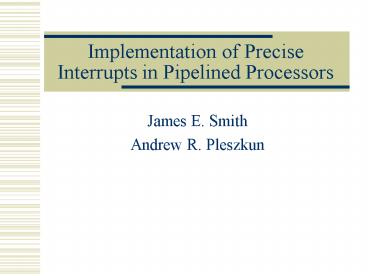Implementation of Precise Interrupts in Pipelined Processors PowerPoint PPT Presentation
1 / 20
Title: Implementation of Precise Interrupts in Pipelined Processors
1
Implementation of Precise Interrupts in Pipelined
Processors
- James E. Smith
- Andrew R. Pleszkun
2
Outline
- Motivation for precise interrupts.
- Types of interrupts.
- What are precise interrupts?
- 5 solutions to the precise interrupt problem.
- Performance results.
- Extensions.
- Conclusions.
3
Motivation
- An interrupt may occur at any time.
- If this happens we need to be able to return to
some point to restart execution. - Still need to get the right answer.
- With pipelining hardware may not be in a state
consistent with any PC value. - This paper presents 5 solutions to this.
4
Types of Interrupts
- Program interrupts.
- traps
- Errors detected while fetching and executing
instructions. - Illegal op-code, numerical errors, page faults
- External interrupts.
- Caused by sources outside the executing process.
- I/O interrupts, timer interrupts
5
Precise Interrupts
- The saved state is consistent with sequential
model of execution. - Process state consists of PC, registers, and
memory. - Three criteria
- Previous instructions have finished.
- Later instructions are completely unexecuted.
- Interrupted instruction has finished/not started.
6
In-Order Instruction Completion (1/5)
- Instructions modify state only when all previous
instructions are known to be exception-free. - Implemented with the result shift register.
- Insures preciseness w.r.t. registers.
- Instruction reserves all stages up to and
including its own. - If an exception is detected, all subsequent
instruction are simply cancelled.
7
Memory and PC Preciseness (1)
- Two methods to make memory precise.
- Force stores to wait until the result shift
register is empty before issuing. - Stores can wait in the load/store pipeline until
all preceding instructions are exception free. - To make program counter precise
- Simply include the PC with each entry in the
result shift register.
8
Problems with (1)
- Faster instructions may have to wait for slower
ones, even if no dependencies exist between the
two instructions. - Faster instructions block slower instructions
which would need later stages of the result shift
buffer anyway.
9
Reorder Buffer (2/5)
- Results of an instruction are sent to the reorder
buffer. - Here they wait until all preceding instructions
have committed. - This allows instructions to finish out of order.
- When an exception occurs, issue is stopped and no
more instructions are executed and no register
writes are allowed.
10
Memory and PC Preciseness (2)
- Memory can be made precise in 2 ways
- Hold stores in issue register until all previous
instructions are know to be exception free. - Allow dummy stores in the reorder buffer.
- PC preciseness.
- Store the PC in the reorder buffer instead of the
result shift register. - When an exception occurs, use the PC from the ROB.
11
Problems with (2)
- Already computed results must wait in the reorder
buffer when they may be needed by other
instructions which could otherwise execute. - Data dependent instructions must wait until the
result has been committed to register.
12
Bypass Paths (3/5)
- Can implement bypassing, or forwarding, from the
reorder buffer. - Allows data in ROB to be used in place of data in
registers. - Dependent instructions are allowed to issue.
- Only latest entry in ROB can be used.
- Preciseness w.r.t. memory and PC do not change
from (2).
13
Problems with (3)
- Many bypass comparators are needed.
- Lots of extra circuitry is required for the
multiple bypass check. - Fortunately, the circuitry is conceptually simple.
14
History File (4/5)
- Uses a history buffer, much like a reorder
buffer. - Stores register number and contents before
change. - Results go straight into the registers if there
is no exception. - On an exception the history buffer is emptied,
resetting the registers they contain.
15
Memory and PC Preciseness (4)
- The precise PC can be found at the head of the
history buffer. - Stores can wait in the issue register or be
blocked in the memory pipeline.
16
Future File (5/5)
- Uses two separate register files
- Architectural file - Represents sequential
execution. - Future file - Updated immediately upon
instruction execution and used as the working
file. - When instruction reaches the head of ROB, it is
committed to the architectural file. - On an exception changes are brought over from the
architectural file to the future file based on
which instructions are still represented in the
ROB. - Preciseness maintained just as with (4).
17
Performance Measurements
- Cray-1S simulation system was used.
- Workload was the first 14 Lawrence Livermore
Loops. - (3), (4), and (5) all performed the same, so are
represented simply as (3). - Number of buffer entries was varied to assess
effect on performance.
18
Results Tables
19
Extensions
- These methods can be modified to provide support
for the following extensions - Handling other state values.
- Virtual memory.
- Cache-Memory.
- Linear pipeline structures.
20
Conclusion
- This paper presented five methods to provide
precise interrupts. - Through simulation, these methods were shown to
reduce performance by as little as 3. - Varying implementation costs may make a slower
but cheaper method more appropriate.

